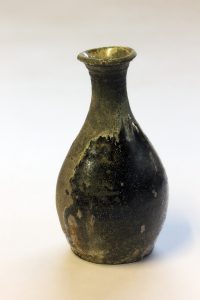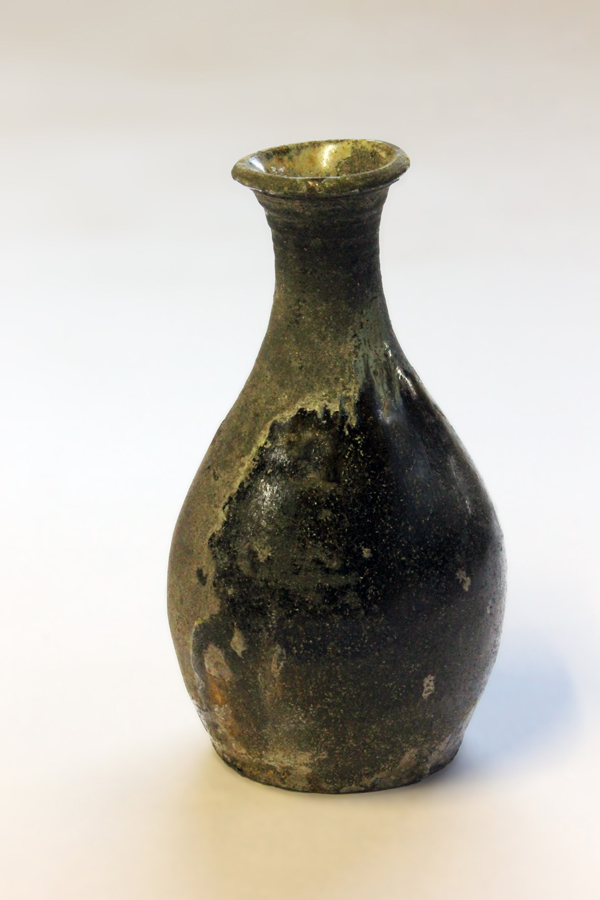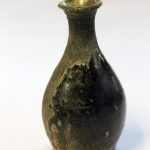Ishiyama Tetsuya
Chosen-garatsu is especially popular as tokkuri. Even the most rudimentary collection of saké vessels is likely to include at least one tokkuri of Chosen-garatsu, as well as representatives of such other saké standbys as Bizen and kohiki (white slip).
The two-tone patterns of Chosen-garatsu have always struck me as somewhat contrived, and I’ve never been much of an aficionado of the pottery. My curiosity got the better of me, however, when I received a call from a pottery dealer in Tokyo. A Momoyama period Chosen-garatsu tokkuri was available, he confided, for more not much more than the price of a shard. The dealer cautioned me, however, that the price was still pretty high, given the condition of the piece. Someone, he explained, had applied a thick layer of black paint to the work, possibly as a mode of repair.
I figured that I ought to have the piece around for purposes of study and asked the dealer to go ahead and send it my way. When I opened the package, the reason for his diffidence was all too apparent. The paint covered the piece from head to toe. Faint traces of the original finish were visible, though, and they identified the piece unmistakably as Momoyama Chosen-garatsu. The tokkuri had a coating of dark, muscovado-like glaze and flecks of bluish mottling on the neck and at the mouth.
Removing the paint proved a challenge. The stubborn black coating yielded neither to scrubbing with paint thinner nor to immersing in boiling water. I finally managed to remove it with acetone, however, and thereby revealed the countenance that the paint had concealed. Chosen-garatsu’s iron-and-ash glazes and other ash glazes contain high concentrations of silicic acid and are prone to separation over the years. And my tokkuri had lost about half of its original glaze, which might have been the motivation for the clumsy paint job. From a distance, you could easily mistake it for a Bizen tokkuri.
Enough remained of the glaze, however, to provide a basic grasp of the tokkuri’s original appearance. Here was a truly superior work that, had it survived intact, would have qualified as a masterpiece of Momoyama pottery. My tokkuri had lost what had evidently been an exquisite finish, but its very misfortune had engendered a new and compelling appeal. The separation of the glaze had exposed more of the underlying work than we ordinarily see. It had revealed the marks of turning on the potter’s wheel, for example, on the neck and around the thick-lipped mouth.
I struggled to comprehend how anyone could have seen fit to smother such a work in black paint. Yet I was grateful that the abusive “maintenance” had rendered the work and its wealth of insights affordable for this impoverished potter.
* * *
Let me note here that the appellation “Chosen-garatsu” is problematic. “Chosen” suggests Korean origins for the pottery, either through potters abducted or lured from Korea or through Japanese emulation of imported pottery. And histories of Japanese pottery commonly cite Korea’s Hoeryong and Myongchon pottery as progenitors of Japan’s Madara-garatsu (mottled Karatsu) and Chosen-garatsu.
Here is our first problem with the conventional histories: The oldest extant examples of Hoeryong and Myongchon that resemble their supposed Japanese progeny date from the 18th century. Only through a time warp could they have influenced Japanese pottery that was in full flower by the 16th century. We wonder, conversely, if Korea’s Hoeryong and Myongchon couldn’t have originated through the emulation of Japanese precedents. Let us hope that future research will elucidate the ceramic pedigrees.
Here is a second problem: The combination of “caramel” glazes and cloudy glazes that characterizes Chosen-garatsu was common in China before anything similar emerged in Korea. Excavations have unearthed Tang-dynasty (618–907) shards in China’s Sichuan Province that are identical to Japan’s so-called Chosen-garatsu. Those specimens predate by far anything similar from Korean kilns. The name Karatsu, incidentally, means “China (Kara) port (tsu)” and speaks of the region’s long history of robust exchange with China. If we would seek the roots of Chosen-garatsu on the Asian continent, we should perhaps look to China, rather than Korea.
The problems with the conventional histories of Madara-garatsu and Chosen-garatsu reflect a larger problem with the historical positioning of Karatsu pottery overall. A precursor of Karatsu pottery had taken hold before Japan’s two invasions of Korea in the 1590s. That proto-Karatsu differed fundamentally from its Korean contemporaries in the shapes of the vessels, in the techniques employed, and in the kiln configurations. This is a subject worth revisiting, which I look forward to doing in a follow-up column.








